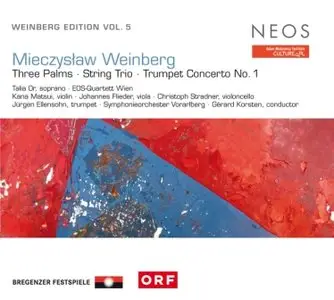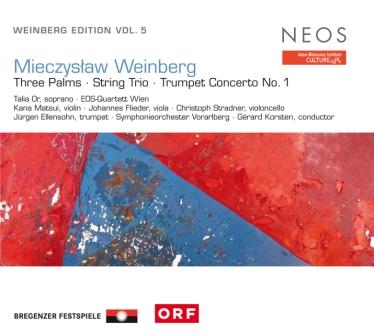Mieczyslaw Weinberg - 3 Palms, String Trio, Trumpet Concerto No. 1 - Weinberg Edition, Vol. 5
Classical | EAC: FLAC+Cue+Log | 1 Cd, Cover+Booklet | 350 Mb
Label: NEOS - Date: 2011
Classical | EAC: FLAC+Cue+Log | 1 Cd, Cover+Booklet | 350 Mb
Label: NEOS - Date: 2011
Three Palms for string quartet and soprano, op. 120 (1977): A poem by Mikhail Yuryevich Lermontov (1814–1841) speaks of three palm trees in the Arabian desert. Weinberg used this text as the basis of his like-named work, scored for the unusual combination of soprano and string quartet. The character of this 20-minute work, conceived in 1977, comes from its mixture of chamber music, song cycle and cantata.Tracks:
Stylistically it is uncommonly expressive, interspersed with many lyrical passages. Its model was surely Arnold Schoenberg’s Second String Quartet, op. 10 (1908), which likewise adds a soprano voice to the sound of a string quartet. Schoenberg’s work, too, comes to terms with a profoundly personal experience – a relation likewise important to Weinberg in his op. 120. In Lermontov’s poem, three palm trees complain to God about their uselessness.
The response has a violence reminiscent of the Old Testament: a group of Bedouins arrive and use the trees for their campfire. Only in their deaths are the trees given their raison d’être. Therein lies the piece’s symbolic message. Weinberg has retraced feelings of loneliness, and later of rage and despair, as if in silverpoint. Chromatic turns of phrase, reflecting the topos of suffering in earlier music, undergird the sorrow of this sacrifice, which, toward the end, leads to absolute desolation.
Whether the three palm trees are emblematic of the Holocaust, the deaths of Weinberg’s three family members or his own sufferings in the artistic dictatorship of the Soviet Union remains an open question. Perhaps all these aspects played a role in the music. Whatever the case, his great empathy for the fate of the three palm trees is everywhere apparent, impressively transformed into music.
Trio for Violin, Viola and Violoncello op. 48 (1950): Mieczysław Weinberg wrote his String Trio, op. 48, as early as 1950, but the work remained unpublished for many years, and until 2007 it existed only the form of an autograph score. Its origins in the Stalin years may have affected its earnest character. It has been suggested that Weinberg envisioned a performance by musicians at Moscow’s Bolshoi Theatre, but in the end the work only resurfaced after his death.
In musical terms it may be viewed as a dance suite. Ever since the days of Mozart and Beethoven the string trio genre has had a playful divertimento character, unlike the more learned string quartet. This dance element also prevails in Weinberg’s String Trio, though coupled with an admixture of melancholy. The origins of the folk influences in Weinberg’s music are often impossible to pinpoint. His periods of residence in Poland, Byelorussia and Uzbekistan surely had an influence on him, and Moldavia and, of course, Russian folk music were important sources of inspiration. But he always availed himself of a genuine Jewish musical style that merged with the folk cultures in each of these countries.
It is equally possible to listen to a work like the String Trio as a composition by a man forced into “inner immigration”. The festive character of the opening Allegro has a slightly sarcastic undertone. The D-minor Andante mingles the sorrowful vocal lines with a note of defiance – an effect reminiscent of the proud slow sections of an Hungarian csárdás. All three musicians are involved in the score on an equal basis. The sound has the lightness of chamber music that rises in some passages to an almost orchestral splendour. In this small but substantial work, Weinberg succeeds in creating a fiery plea for artistic freedom. Heard in this light, the long dormancy of this masterpiece seems almost self-explanatory.
Trumpet Concerto in B-flat major, op. 94 (1967): Unlike Shostakovich, the ever-curious Weinberg also wrote concertos for otherwise neglected instruments, including the flute, clarinet and trumpet. The latter instrument also plays a leading role in Russia’s circus music. In the Soviet period, these spectacles were even managed by a specially appointed government authority. Many leading composers wrote music for acrobats and clowns under the Big Top.
In Weinberg’s Trumpet Concerto of 1967 the boisterous circus antics of the rhythmically forceful and garish opening movement are mingled with a touch of sarcasm. The middle movement in particular, with its alternating series of bombastic and contemplative “episodes”, sounds like the mental drama of a dolorous clown – perhaps a self-reflection of the composer.
Premièred in 1968, Weinberg’s Trumpet Concerto was written for the outstanding trumpeter Timofei Dokshitzer, the world-famous arranger of Arutiunian’s Trumpet Concerto. The soloist can flex his limbs in a large cadenza in the final movement. The design of this tranquil finale is extraordinary: it contains a stately number of familiar quotations, including the fanfare from Mendelssohn’s Wedding March at the opening, followed by allusions to the crow of the rooster from Rimsky-Korsakov’s Golden Cockerel and the March of the Street Urchins from Bizet’s Carmen.
Surely other quotations and military fanfares lurk in its pages as well. Instead of ending with an expected madcap stretta, Weinberg concluded the concerto with a farewell collage beholden to the spirit of modern music. Shostakovich was so impressed by this novel structure that he referred to the concerto as a “symphony for trumpet and orchestra”.
01. 3 Palms, Op. 120 [0:23:04.07]
02. String Trio, Op. 48 - I. Allegro [0:05:22.56]
03. II. Andante [0:05:32.15]
04. III. Moderato assai [0:04:23.22]
05. Trumpet Concerto No. 1 in B flat major, Op. 94 - I. Etudes [0:08:06.16]
06. II. Episodes [0:08:55.04]
07. III. Fanfares [0:05:47.36]
Exact Audio Copy V1.0 beta 3 from 29. August 2011
EAC extraction logfile from 27. February 2013, 0:11
Mieczyslaw Weinberg / 3 Palms, String Trio, Trumpet Concerto No. 1 - Weinberg Edition, Vol. 5 (Or, Ellensohn, Matsui, Flieder, Stradner, Korsten)
Used drive : TSSTcorpCDDVDW SH-S223C Adapter: 2 ID: 1
Read mode : Secure
Utilize accurate stream : Yes
Defeat audio cache : Yes
Make use of C2 pointers : No
Read offset correction : 697
Overread into Lead-In and Lead-Out : No
Fill up missing offset samples with silence : Yes
Delete leading and trailing silent blocks : No
Null samples used in CRC calculations : Yes
Used interface : Native Win32 interface for Win NT & 2000
Used output format : User Defined Encoder
Selected bitrate : 896 kBit/s
Quality : High
Add ID3 tag : No
Command line compressor : C:\Program Files (x86)\Exact Audio Copy\FLAC\FLAC.EXE
Additional command line options : -V -0 -T "COMMENT=Ripped by Tapaz9" -T "artist=%artist%" -T "title=%title%" -T "album=%albumtitle%" -T "date=%year%" -T "tracknumber=%tracknr%" -T "genre=%genre%" %source%
TOC of the extracted CD
Track | Start | Length | Start sector | End sector
––––––––––––––––––––––––––––-
1 | 0:00.00 | 23:04.07 | 0 | 103806
2 | 23:04.07 | 5:22.56 | 103807 | 128012
3 | 28:26.63 | 5:32.15 | 128013 | 152927
4 | 33:59.03 | 4:23.22 | 152928 | 172674
5 | 38:22.25 | 8:06.16 | 172675 | 209140
6 | 46:28.41 | 8:55.04 | 209141 | 249269
7 | 55:23.45 | 5:47.36 | 249270 | 275330
Range status and errors
Selected range
Filename F:\Musique\Weinberg, Mieczyslaw\Weinberg_WeinbergEditionVol5\Weinberg Edition, Vol. 5 (Or, Ellensohn, Matsui, Flieder, Stradner, Korsten).wav
Peak level 92.0 %
Extraction speed 15.3 X
Range quality 100.0 %
Copy CRC 84010ACF
Copy OK
No errors occurred
End of status report
==== Log checksum 0D5B63740FD813D927F0442D6A23EFFEF8D7462D4550DD277605684C7F026FAB ====



